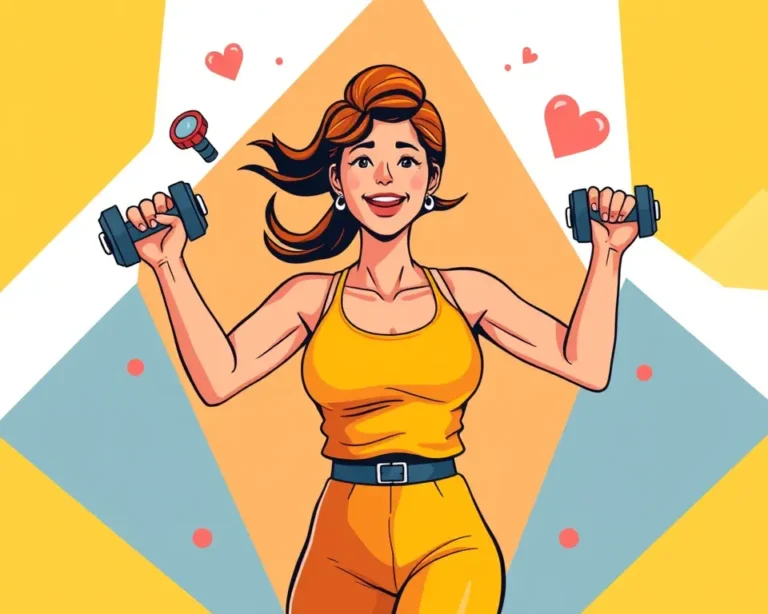Davina McCall, a prominent figure in British media, has become an advocate for fitness, particularly after turning 50. She frequently shares her workout routines and promotes a healthy lifestyle, inspiring many. But is Davina McCall’s workout regime realistic and safe for women aged 50 and over? This article examines the various aspects of her fitness approach and considers its suitability for this demographic.
Understanding Davina McCall’s Workout Style
Davina McCall is known for her dedication to fitness, often incorporating High-Intensity Interval Training (HIIT), weight training, plyometrics, and regular cardio into her routine. She emphasizes the importance of consistency and pushing oneself to achieve fitness goals.
- HIIT Workouts: Davina is known for her HIIT workouts, which involve short bursts of intense exercise followed by brief recovery periods.
- Weight Training: She incorporates weight training to build strength and protect bone density.
- Plyometrics: Davina advocates for plyometric exercises like jumping to improve bone density.
- Cardio: Her routine includes brisk walking and running to maintain cardiovascular health.
- Early Starts: Davina typically starts her workouts early in the morning to stay consistent.
Fitness Considerations for Women Over 50
As women age, their bodies undergo several changes, especially during and after menopause, impacting their fitness needs and capabilities. It’s essential to consider these factors when evaluating the suitability of any workout regime.
- Hormonal Changes: Menopause leads to decreased estrogen levels, accelerating muscle loss (sarcopenia) and bone density reduction (osteoporosis).
- Muscle Loss: Adults can lose 10% of their muscle mass by age 50, with further loss in subsequent decades.
- Bone Density: Bone density diminishes rapidly in the years following menopause, increasing the risk of fractures.
- Joint Health: Conditions like arthritis become more prevalent, affecting joint mobility and increasing the risk of injury.
- Heart Health: The risk of heart disease increases after menopause.
- Metabolism: Metabolism slows down with age, making weight management more challenging.
Key Components of a Realistic Workout for Women 50+
A realistic and safe workout program for women over 50 should include a combination of cardiovascular exercise, strength training, balance exercises, and flexibility work.
- Cardiovascular Exercise: Activities like walking, swimming, cycling, and dancing improve heart health and burn fat. Aim for at least 150 minutes of moderate aerobic activity per week.
- Strength Training: Lifting weights or using resistance bands helps maintain muscle mass, improve posture, and reduce the risk of back injury. Strength training should be incorporated at least twice a week.
- Balance Exercises: Activities like yoga, Tai Chi, and Pilates improve stability and reduce the risk of falls.
- Flexibility and Stretching: Stretching exercises maintain range of motion, reduce muscle soreness, and prevent injury. Yoga and Pilates are good options.
Is Davina McCall’s Workout Realistic?
Davina McCall’s fitness regime is highly demanding and requires a significant time commitment and a high level of physical fitness. While her dedication is admirable, some aspects may not be realistic or safe for all women over 50.
- Intensity: HIIT workouts, while effective, can be intense and may not be suitable for individuals with joint issues or cardiovascular concerns.
- Plyometrics: Jumping exercises can be hard on the joints and may not be appropriate for those with osteoporosis or arthritis.
- Weight Training: Lifting heavy weights can be beneficial, but it’s crucial to start with lighter weights and gradually increase the load to avoid injury.
- Early Starts: Waking up at 6:15 am for workouts may not be feasible for everyone due to work schedules or other commitments.
- Time Commitment: Davina’s routine involves a considerable time investment, which may be challenging for women with busy lifestyles.
Expert Opinions
Fitness experts recommend a balanced approach to exercise for women over 50, emphasizing the importance of tailoring workouts to individual needs and abilities.
- WebMD: Suggests aerobic exercise, strength training, and stretching as essential components of a fitness program for women over 50.
- Johns Hopkins Medicine: Recommends a range of activities, including aerobic, strength, and balance training, emphasizing the importance of starting slowly and finding activities you enjoy.
- The Healthy Back Bag: Highlights the importance of aerobic activity, strength training, and stress management for women over 50.
- Henry Ford Health: Recommends stationary biking, strength training with dumbbells, and group activities for staying active after 50.
- Australian Seniors: Suggests incorporating resistance training, balance exercises, and core stability exercises like Pilates and yoga.
- National Institute on Aging: Recommends 150 minutes per week of moderate-level exercise, including strength training, and emphasizes the importance of setting realistic goals.
- Stanford Medicine: Highlights the link between age and muscle mass, emphasizing the importance of strength training for women over 50 to combat muscle loss.
- EatingWell: Recommends functional exercises, water workouts, biking, and resistance exercise for women over 50.
How to Adapt Davina McCall’s Workout for Women Over 50
While some aspects of Davina McCall’s workout may not be suitable for all women over 50, it is possible to adapt her approach to create a more realistic and safe program.
- Consult a Doctor: Before starting any new workout regime, consult a healthcare provider to ensure it is safe and appropriate for your individual health conditions.
- Start Slowly: Begin with lower-intensity exercises and gradually increase the intensity and duration as your fitness level improves.
- Modify Exercises: Adapt exercises to suit your abilities and limitations. For example, modify push-ups by doing them against a wall or on your knees.
- Focus on Form: Prioritize proper form over speed or weight to prevent injuries.
- Listen to Your Body: Pay attention to your body’s signals and rest when needed. Don’t push yourself too hard, especially when starting.
- Incorporate Variety: Include a mix of cardio, strength training, balance exercises, and flexibility work to target different aspects of fitness.
- Set Realistic Goals: Set achievable goals and celebrate your progress along the way.
- Stay Consistent: Aim for regular exercise, but don’t feel pressured to replicate Davina McCall’s intense routine. Consistency is more important than intensity.
- Make it Enjoyable: Choose activities you enjoy to stay motivated and make exercise a sustainable part of your lifestyle.
- Consider a Personal Trainer: Work with a qualified personal trainer who can create a customized workout plan tailored to your specific needs and goals.
Benefits of Exercise for Women Over 50
Regular exercise offers numerous benefits for women over 50, including:
- Maintaining a Healthy Weight: Exercise helps burn calories and manage weight, combating the slowing metabolism that often occurs with age.
- Reducing Risk of Chronic Diseases: Physical activity lowers the risk of heart disease, diabetes, osteoporosis, and certain cancers.
- Strengthening Muscles and Bones: Strength training helps maintain muscle mass and bone density, reducing the risk of falls and fractures.
- Improving Mood and Cognitive Function: Exercise releases endorphins, which have mood-boosting effects, and improves memory, learning, and problem-solving skills.
- Boosting Energy Levels: Regular physical activity can combat fatigue and increase energy levels.
- Improving Sleep: Exercise can promote better sleep quality.
- Enhancing Overall Quality of Life: Staying active can improve independence, social connections, and overall well-being.
Conclusion
Davina McCall’s dedication to fitness is inspiring, but her workout regime may not be realistic or safe for all women over 50. It’s essential to consider individual fitness levels, health conditions, and time constraints when designing a workout program. A balanced approach that includes cardiovascular exercise, strength training, balance exercises, and flexibility work is key. By adapting Davina McCall’s approach and listening to their bodies, women over 50 can achieve their fitness goals and enjoy the numerous benefits of regular exercise.







